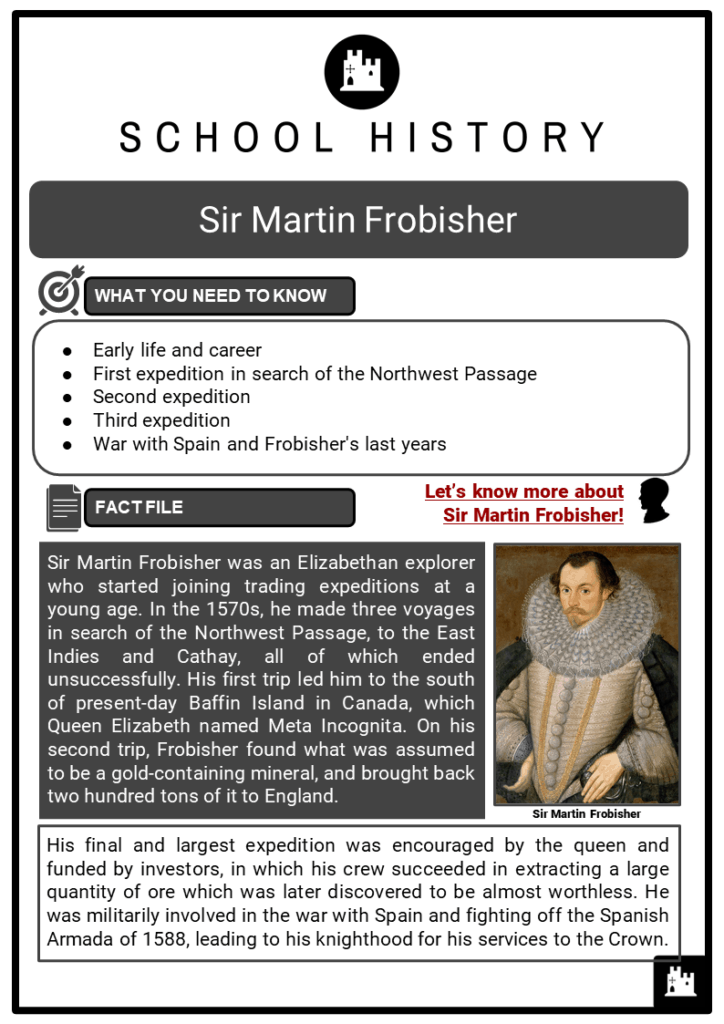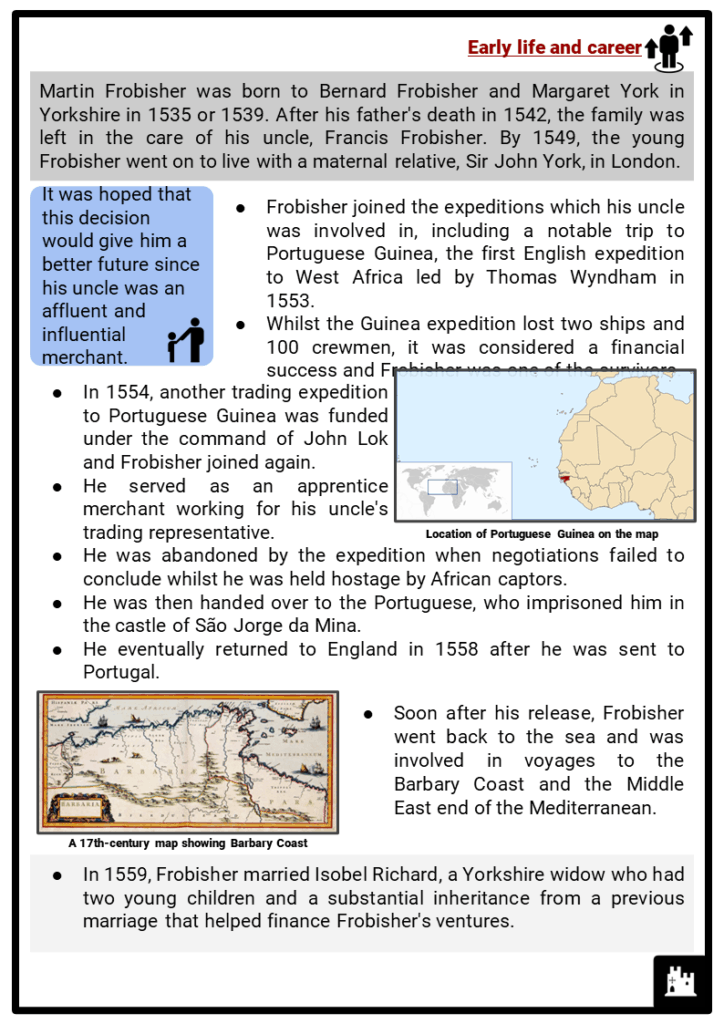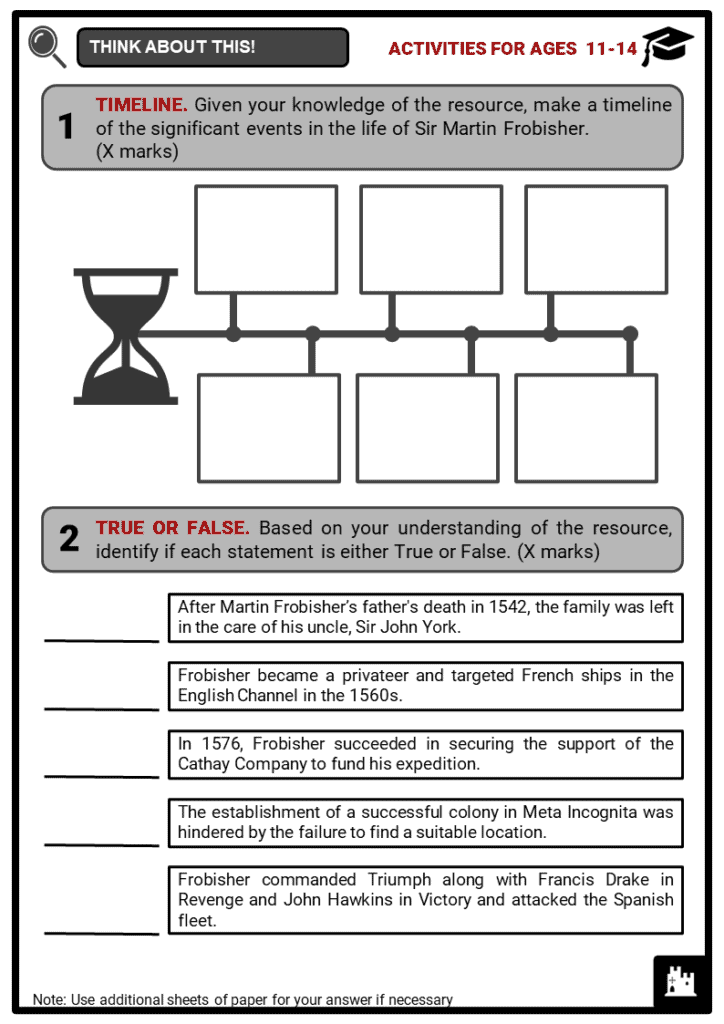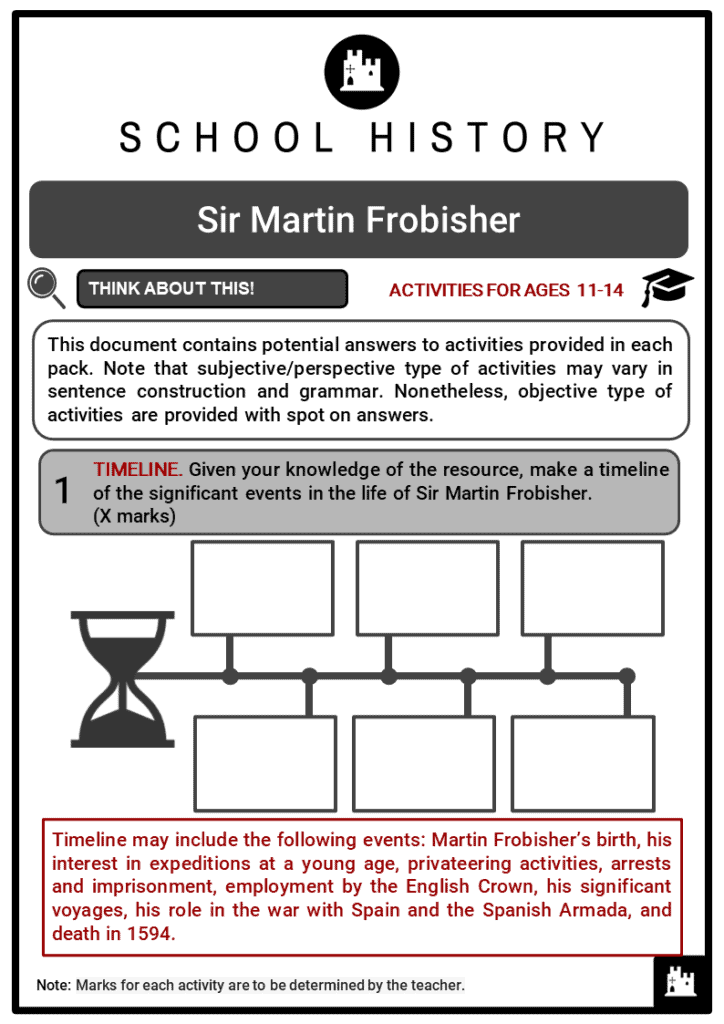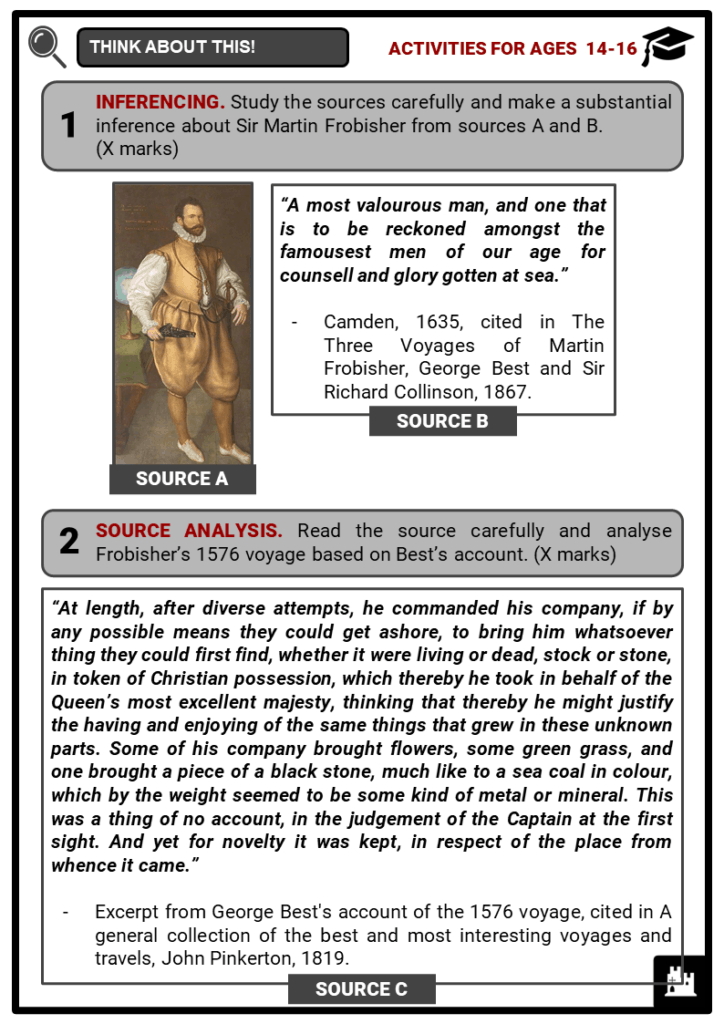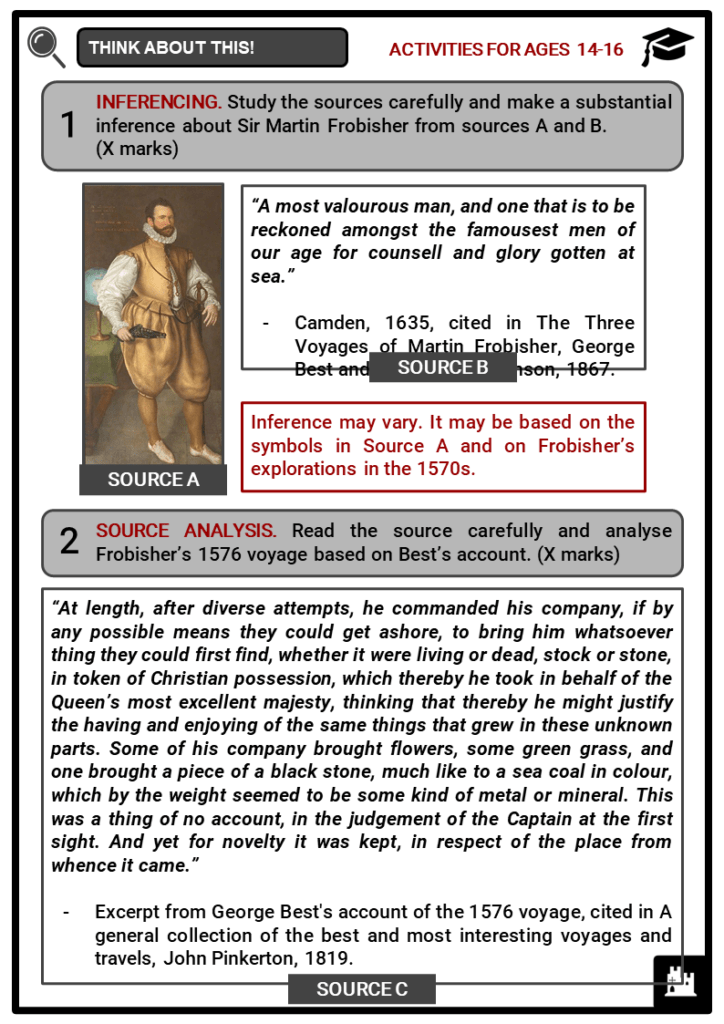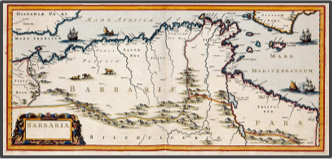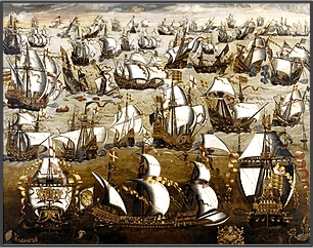Download Sir Martin Frobisher Worksheets
Do you want to save dozens of hours in time? Get your evenings and weekends back? Be able to teach Sir Martin Frobisher to your students?
Our worksheet bundle includes a fact file and printable worksheets and student activities. Perfect for both the classroom and homeschooling!
Table of Contents
Add a header to begin generating the table of contents
Summary
- Early life and career
- First expedition in search of the Northwest Passage
- Second expedition
- Third expedition
- War with Spain and Frobisher's last years
Key Facts And Information
Let’s know more about Sir Martin Frobisher!
- Sir Martin Frobisher was an Elizabethan explorer who started joining trading expeditions at a young age. In the 1570s, he made three voyages in search of the Northwest Passage, to the East Indies and Cathay, all of which ended unsuccessfully. His first trip led him to the south of present-day Baffin Island in Canada, which Queen Elizabeth named Meta Incognita. On his second trip, Frobisher found what was assumed to be a gold-containing mineral, and brought back two hundred tons of it to England.
- His final and largest expedition was encouraged by the queen and funded by investors, in which his crew succeeded in extracting a large quantity of ore which was later discovered to be almost worthless. He was militarily involved in the war with Spain and fighting off the Spanish Armada of 1588, leading to his knighthood for his services to the Crown.
Early life and career
- Martin Frobisher was born to Bernard Frobisher and Margaret York in Yorkshire in 1535 or 1539. After his father's death in 1542, the family was left in the care of his uncle, Francis Frobisher. By 1549, the young Frobisher went on to live with a maternal relative, Sir John York, in London.
- Frobisher joined the expeditions which his uncle was involved in, including a notable trip to Portuguese Guinea, the first English expedition to West Africa led by Thomas Wyndham in 1553.
- Whilst the Guinea expedition lost two ships and 100 crewmen, it was considered a financial success and Frobisher was one of the survivors.
- In 1554, another trading expedition to Portuguese Guinea was funded under the command of John Lok and Frobisher joined again.
- He served as an apprentice merchant working for his uncle's trading representative.
- He was abandoned by the expedition when negotiations failed to conclude whilst he was held hostage by African captors.
- He was then handed over to the Portuguese, who imprisoned him in the castle of São Jorge da Mina.
- He eventually returned to England in 1558 after he was sent to Portugal.
- Soon after his release, Frobisher went back to the sea and was involved in voyages to the Barbary Coast and the Middle East end of the Mediterranean.
- In 1559, Frobisher married Isobel Richard, a Yorkshire widow who had two young children and a substantial inheritance from a previous marriage that helped finance Frobisher's ventures.
- In the 1560s, Frobisher became involved in privateering ventures, first with his brother, John Frobisher, and a fellow Yorkshireman, John Appleyard.
- They targeted French ships in the English Channel.
- Frobisher was arrested on charges of piracy but was later released from prison in 1564.
- He bought two ships upon his release, the Mary Flower and William Baxter, intended for trading expeditions to the Guinea coast.
- Again, he was imprisoned briefly when he was seized along with William Baxter in Scarborough.
- Another venture led to another brief arrest in 1569.
- With the help of the lord admiral, Edward Fiennes de Clinton and Queen Elizabeth I's chief minister, William Cecil, he was set free in 1570.
- Cecil became interested in the adventurer and signed Frobisher up to the exploration for the Crown starting in 1571.
First expedition in search of the Northwest Passage
- In around 1560 or 1561, Frobisher first made the decision to embark on a journey in search of a passage to the north-west that would constitute a new route for trade with the East Indies and Cathay (present-day China). It took him fifteen years to put together the funding for his project.
- In 1576, Frobisher succeeded in securing the support of the Muscovy Company, an English merchant consortium that had previously funded several expeditions in search of the Northwest Passage.
- With the help of Michael Lok, the director of the company, Frobisher was able to raise enough funds for three sailing ships: Gabriel and Michael of about twenty to twenty-five tons each, and a small ten-ton vessel, with a crew of thirty-five men in total.
- He anchored at Blackwall and sailed on 7 June 1576 to the Shetland Islands with the assent of Queen Elizabeth I at Greenwich Palace.
- He lost the smaller vessel and was also forced to abandon the Michael, but on 28 July the Labrador coast was sighted.
- He named this landmass Queen Elizabeth's Foreland.
- A few days later the crew reached the inlet of Frobisher Bay and since the ice and wind hindered travel to the north, Frobisher gave orders to sail westwards to see if he could get out into the open sea.
- They arrived at the southern part of present-day Baffin Island on 18 August 1576 and came into contact with some natives.
- After agreeing with one of the local Inuits to guide him through the area, Frobisher ordered five of his men to accompany him back to shore on a boat, advising them to avoid getting too close to other natives.
- In all likelihood, his men disregarded the order and were captured and taken prisoner by the Inuit.
- After days of searching, Frobisher had not yet intercepted them and eventually convinced the Inuit he had met to bring him to the other natives in order to try and negotiate an exchange for the missing sailors.
- The attempt proved in vain and the five crew members were never found, although an Inuit legend says that the men lived with them for a few years before dying in an attempt to leave Baffin Island on a boat they had built.
- Frobisher returned to London in October and Elizabeth I named the inhospitable white desert Meta Incognita or Unknown Frontier.
- Among other things, a piece of a black stone was taken, which was believed to contain gold by one of the four experts consulted.
Second expedition
- The following year, a much larger expedition was organised. The queen provided the Royal Navy ship Ayde to the Company of Cathay and invested a thousand pounds in Frobisher’s expedition.
- The Company of Cathay was also granted a licence giving an exclusive right of navigation in all directions except for the East.
- Frobisher was named High Admiral of all the Lands and Waters he had managed to discover.
- On 27 May 1577, the expedition was joined by the ships Gabriel and Michael and a total of 120 men including miners, refinery workers and soldiers.
- Frobisher's fleet also consisted of second-in-command Lieutenant George Best, Christopher Hall as master, and the navigator Edward Fenton in command of Gabriel.
- They left Blackwall and sailed from the north of Scotland reaching Frobisher Bay on 17 July.
- A few days later, Frobisher officially took possession of the entire region and the south side of the Bay.
- Whilst several weeks went on collecting the ore, very little progress was made in exploring the island.
- Long negotiations and skirmishes with the natives took place as well as useless attempts to recover the men captured the previous year.
- The expedition's departure from the island began on 23 August, and Ayde reached Milford Haven on 23 September.
- Gabriel and Michael arrived later, separately in Bristol and Yarmouth.
- Frobisher forcibly took three Inuits, namely Kalicho, Arnaq and Nuttaaq, who all died soon after their arrival in England.
- He was welcomed and honoured by the queen at Windsor.
- Large preparations were made and substantial expenses were incurred to examine the amount of ore transported to the homeland (about two hundred tons).
Third expedition
- The confidence of the queen and others in the potential of the newly discovered territories remained firm. It was therefore decided to set up the largest of the expeditions, with everything necessary to establish a colony of one hundred individuals. Frobisher was again honoured by the queen, who placed a fine gold chain around his neck.
- On 3 June 1578, the expedition was made up of a total of fifteen vessels: the flagship Ayde, Michael, Gabriel, Judith, Dennis or Dionyse, Anne Francis, Francis of Foy, Moon of Foy, Bear of Leycester, Thomas of Ipswich, Thomas Allen, Armenall, Soloman of Weymouth, Hopewell, and Emanuel of Bridgwater, and a total of 400 men including 147 miners, 4 blacksmiths and 5 assayers.
- It departed from Harwich and sailed across the English Channel on 20 June, reaching the south of Greenland where Frobisher and some of his men managed to land.
- The foreland of Frobisher Bay was sighted on 2 July.
- The stormy sea and the dangerous icy conditions prevented the docking, and besides causing the sinking of the Dennis – a hundred-ton sailing ship – they pushed the fleet into another strait, now known as Hudson.
- After travelling about sixty miles along this wrong strait, Frobisher reversed course with obvious reluctance, and after several pitches and separations between the units, the fleet could finally drop anchor in Frobisher Bay.
- Attempts were made to find accommodation for the colony whilst a large quantity of ore was loaded.
- The establishment of a successful colony was hindered by the discontent and disagreement among the settlers.
- On the last day of August, the fleet left to return to England and arrived in early October.
- The cargo was immediately taken to a fusion plant on Powder Mill Lane in Dartford, Kent.
- Despite various attempts, the mineral apparently did not even cover the costs of fusion and was eventually used for the construction of roads.
- This disastrous discovery led to the Cathay Company's bankruptcy and the end of Frobisher’s attempts to patrol the Northwest Passage
War with Spain and Frobisher's last years
- In 1580, Frobisher served as captain on one of the queen’s ships, with the task of preventing Spain’s attempts to support the Irish in their resistance to the English Crown. In the same year, he was awarded the office of Chancellor of the Royal Navy.
- In 1585, Frobisher commanded Primrose, as Sir Francis Drake’s vice admiral in his expedition to the West Indies.
- Shortly thereafter, the country was threatened by incursions of the Invincible Armada, and Frobisher was one of those men of extraordinary experience that the kingdom had at the time that Drake had recommended in a letter to the queen
- He commanded Triumph along with Francis Drake in Revenge and John Hawkins in Victory and attacked the Spanish fleet.
- For the exceptional services rendered in the dispersion of the Armada, Martin Frobisher was knighted on 26 July 1588.
- He continued to cross the Channel until 1590 when he was commissioned to command a small fleet towards the coasts of Spain harassing Spanish shipping and intercepting Spanish treasure galleons.
- In 1591, Frobisher returned to Altofts in Yorkshire where he married his second wife, daughter of Lord Wentworth, becoming at the same time landowner of a manor in Whitwood in Yorkshire and of Finningley Grange in Nottinghamshire.
- However, he found life in the country unappealing and the following year he took command of an armed fleet from Sir Walter Raleigh to the Spanish coast, from where he returned with a huge loot.
- In November 1594, he was employed by a rescue squadron in Brest where he was shot at Fort Crozon, a fortress defended by the Spanish.
- Due to inadequate medical assistance, he died a few days later on 15 November in Plymouth.
- His heart was buried in the St Andrew's Church, Plymouth on 22 November whilst his body was later transported to London and buried in St Giles-without-Cripplegate.
Image sources:
- https://upload.wikimedia.org/wikipedia/commons/thumb/4/4e/Atlas_Van_der_Hagen-KW1049B13_057-BARBARIA.jpeg/400px-Atlas_Van_der_Hagen-KW1049B13_057-BARBARIA.jpeg
- https://upload.wikimedia.org/wikipedia/commons/2/20/1590_or_later_Marcus_Gheeraerts%2C_Sir_Francis_Drake_Buckland_Abbey%2C_Devon.jpg
- https://upload.wikimedia.org/wikipedia/commons/thumb/1/17/Invincible_Armada.jpg/300px-Invincible_Armada.jpg

